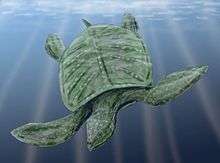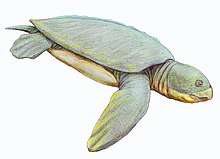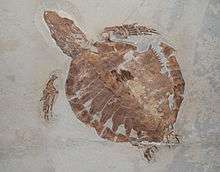Protostegidae
Protostegidae is a family of extinct marine turtles that lived during the Cretaceous period. The family includes some of the largest sea turtles that ever existed. The largest, Archelon, had a head one metre (39 in) long. Like most sea turtles, they had flattened bodies and flippers for front appendages; protostegids had minimal shells like leatherback turtles of modern times.
| Protostegids | |
|---|---|
 | |
| Life restoration of Archelon ischyros | |
| Scientific classification | |
| Kingdom: | Animalia |
| Phylum: | Chordata |
| Class: | Reptilia |
| Order: | Testudines |
| Suborder: | Cryptodira |
| Clade: | Panchelonioidea |
| Family: | †Protostegidae Cope, 1872 |
| Type species | |
| †Protostega gigas Cope, 1872 | |
| Genera | |
Anatomy

As some of the first marine turtles, the protostegids set the general body plan for future species of sea turtles. They had a generally depressed turtle body plan, complete with four limbs, a short tail, and a large head at the end of a relatively short neck. Like other sea turtles, they possessed oar-like front appendages especially evolved for swimming in the open ocean. Similar to the still-extant, possibly closely related Dermochelyidae, protostegids possessed extremely reduced carapaces. Some specimens had skeletal protrusions from their ribs almost wrapping around their bodies in place of a complete shell. Like modern sea turtles, protostegids had sharp beaks. One of the defining characteristics of the members of the family was their almost-disproportionately large heads. Specifically, some specimens of Archelon have been found with heads one metre (39 in) long. In addition, the members of the family had somewhat reduced plastrons, as well.[4]
Ecology
Trophic ecology
While all members of the family are extinct, palaeoecological studies on the members of the family have provided some insight into the ecological roles of the Protostegidae. Analysis of fossil organs of some protostegids has revealed entire stomachs containing fossilized shellfish.[3] The turtles, in turn, are postulated to have been preyed upon by the major predators of the time. Fossil protostegids have been found with tooth impressions from the large lamnid sharks of the time.[5] Two specimens of Protostega gigas have been discovered to have tooth marks from large sharks. In addition, teeth of the extinct shark Cretoxyrhina mantelli have been found embedded in at least one Protostega skeleton.[6]
Evolutionary history
The family's oldest members are Desmatochelys padillai, known from the specimens recovered from the Early Cretaceous Paja Formation of Colombia[2] and Santanachelys gaffneyi, known from a specimen excavated from Brazil in 1998. The latter species first appeared during the Early Cretaceous. As an early sea turtle, Santanachelys had several unspecialized characteristics, such as distinguishable digits in its flipper-like arms. Later relatives' flippers were completely fused together for more efficient swimming.[3] As with most large fauna of the era, the Protostegidae died out during the events of the Cretaceous–Paleogene extinction event that led to the extinction of the dinosaurs.[7]
The exact phylogenetic position of protostegids among turtles is uncertain. Some phylogenetic studies determine the leatherback turtles in the family Dermochelyidae to be their closest living relatives, with both these families being monophyletic.[3][8] Conversely, the phylogenetic analyses conducted by Joyce (2007) and Anquetin (2012), which included one protostegid species (Santanachelys gaffneyi), recovered the family as only distantly related to leatherback turtles. Joyce (2007) recovered Protostegidae as basal eucryptodiran turtles lying outside the crown group of Cryptodira (the least inclusive clade containing all living cryptodirans) and closely related to Solnhofia parsonsi;[9] Santanachelys had a similar phylogenetic position in the analysis conducted by Anquetin (2012), who stressed that future studies should include more protostegids to confirm this phylogenetic placement.[10] If confirmed, these results would prove that protostegids weren't close relatives of leatherback turtles (or in fact any living cryptodirans), but instead "represent an independent lineage of marine turtles that originated in the Late Jurassic".[9] The analyses conducted by Sterli (2010) and Sterli & de la Fuente (2011) recovered Santanachelys (and, presumably, the entirety of Protostegidae) as even more distantly related to living cryptodirans; it was found to be basal turtle lying outside the crown group of turtles (the least inclusive clade containing cryptodirans and pleurodirans).[11][12]
A phylogenetic analysis conducted by Cadena and Parham (2015) recovered Protostegidae within the crown group of Cryptodira; specifically the family was recovered as belonging to Chelonioidea and more closely related to the leatherback sea turtle than cheloniids are.[2]
Taxonomic history

In 1888, the Belgian zoologist George Albert Boulenger published his classification of the Testudinata within the 9th edition of the Encyclopædia Britannica. The genus Protostega was placed within the family Sphargidae under the suborder Athecae. A year or so later, the entire suborder was downgraded by Karl Alfred von Zittel into a family within the Cryptodira.[13]
In 1994, Hirayama proposed a three-family subdivision of the sea turtle superfamily based on cladistic analysis; Protostegidae was given full, formal family status in the system, containing most of the extinct genera, including Archelon, and a previously undescribed protostegid.[14] The unidentified specimen was fully described in 1998, as the species Santanachelys gaffneyi. The genus Santanachelys was appended to the family after the new species was described. This specimen was later to be analyzed to be the family's oldest member.[3]
References
- "Protostegidae". The Paleobiology Database. Retrieved 27 July 2013.
- Edwin A. Cadena and James F. Parham (2015). "Oldest known marine turtle? A new protostegid from the Lower Cretaceous of Colombia". PaleoBios. 32 (1): 1–42.
- Hirayama, Ren (16 April 1998). "Oldest known sea turtle". Nature. 392 (6677): 705–708. Bibcode:1998Natur.392..705H. doi:10.1038/33669.
- Lutz, Peter L.; John A. Musick (1996). The Biology of Sea Turtles. CRC PRess. pp. 432pp. ISBN 978-0-8493-8422-6.
- Shimada, Kenshu; M.J. Everhart; G. E. Hooks III (2002). "Ichthyodectid fish and protostegid turtle bitten by the Late Cretaceous lamniform shark, Cretoxyrhina mantelli". Journal of Vertebrate Paleontology. 22 (3): 106.
- Shimada, Kenshu; G. E. Hooks III (January 2004). "Shark-bitten protostegid turtles from the upper Cretaceous Mooreville chalk, Alabama". Journal of Paleontology. 78 (1): 205–210. doi:10.1666/0022-3360(2004)078<0205:SPTFTU>2.0.CO;2.
- Zangerl, Rainer (May 1953). "The vertebrate fauna of the Selma Formation of Alabama, Part III. The turtles of the Family Protostegidae". Chicago Field Museum Mem. 3 (3).
- Meylan, Peter A.; Ren Hirayama (September 2000). "The Paleontology and Phylogenetics of "Sea Turtles"". Proceedings of the 19th Annual Symposium on Sea Turtle Conservation and Biology. 19: 104. NOAA Technical Memorandum NMFS-SEFSC-443.
- Walter G. Joyce (2007). "Phylogenetic relationships of Mesozoic turtles" (PDF). Bulletin of the Peabody Museum of Natural History. 48 (1): 3–102. doi:10.3374/0079-032x(2007)48[3:promt]2.0.co;2. Archived from the original (PDF) on 6 June 2013.
- Jérémy Anquetin (2012). "Reassessment of the phylogenetic interrelationships of basal turtles (Testudinata)". Journal of Systematic Palaeontology. 10 (1): 3–45. doi:10.1080/14772019.2011.558928.
- Juliana Sterli (2010). "Phylogenetic relationships among extinct and extant turtles: the position of Pleurodira and the effects of the fossils on rooting crown-group turtles". Contributions to Zoology. 79 (3): 93–106. doi:10.1163/18759866-07903002. hdl:11336/84233.
- Juliana Sterli and Marcelo de la Fuente (2011). "A new turtle from the La Colonia Formation (Campanian–Maastrichtian), Patagonia, Argentina, with remarks on the evolution of the vertebral column in turtles". Palaeontology. 54 (1): 63–78. doi:10.1111/j.1475-4983.2010.01002.x.
- Baur, George (June 1890). "On the Classification of the Testudinata". The American Naturalist. 24 (282): 530–536. doi:10.1086/275138. JSTOR 2450882.
- Hirayama, Ren (December 1994). "Phylogenetic systematics of chelonioid sea turtles". Island Arc. 3 (4): 270–284. doi:10.1111/j.1440-1738.1994.tb00116.x.
Further reading
- Lutz, Peter L.; John A. Musick (1996). The Biology of Sea Turtles. CRC PRess. pp. 432pp. ISBN 978-0-8493-8422-6.
- Kazlev, M. Alan (15 September 2003). "Mesozoic Marine Reptiles". Palaeos Mesozoic. Palaeos. Archived from the original on 15 July 2007. Retrieved 3 September 2007.
- Case, E. C. (1897). "On the osteology and relationships of Protostega". Journal of Morphology. 14: 21–60. doi:10.1002/jmor.1050140103. hdl:2027/mdp.39015082583868.
- Cope, Edward Drinker (1872). "A description of the genus Protostega". Proceedings of the Academy of Natural Sciences of Philadelphia: 422–433.
- Cope, Edward Drinker (1878). "Note of fossils obtained by Mr. Russell S. Hill, including bones of Protostega gigas". The American Naturalist. 12 (2): 137–138. doi:10.1086/272052.
- Hay, O.P. (1895). "On certain portions of the skeleton of Protostega gigas". Field Columbian Museum, Publications, Zoological Series. 1: 57–62.
- Hay, O.P. (1898). "On Protostega, the systematic position of Dermochelys, and the morphogeny of the chelonian carapace and plastron". The American Naturalist. 32 (384): 929–948. doi:10.1086/277069.
- Sternberg, C.H. (1905). "Protostega gigas and other Cretaceous reptiles and fishes from the Kansas chalk". Transactions of the Kansas Academy of Science. 19: 123–128. doi:10.2307/3624190. JSTOR 3624190.
- Wieland, G. R. (1898). "The protostegan plastron". American Journal of Science. 4. 5 (25): 15–20. Bibcode:1898AmJS....5...15W. doi:10.2475/ajs.s4-5.25.15.
- Wieland, G. R. (1906). "The osteology of Protostega". Carnegie Museum, Memoirs. 2: 279–298.
- Wieland, G. R. (1906). "Plastron of the Protosteginae". Carnegie Museum, Annals. 4: 8–14.
- Wieland, G. R. (1909). "Revision of the Protostegidae". American Journal of Science. 4. 27 (158): 101–130. Bibcode:1909AmJS...27..101W. doi:10.2475/ajs.s4-27.158.101.
- Williston, S. W. (1902). "On the hind limb of Protostega". American Journal of Science. 4. 13 (76): 276–278. Bibcode:1902AmJS...13..276W. doi:10.2475/ajs.s4-13.76.276.
| Wikispecies has information related to Protostegidae |